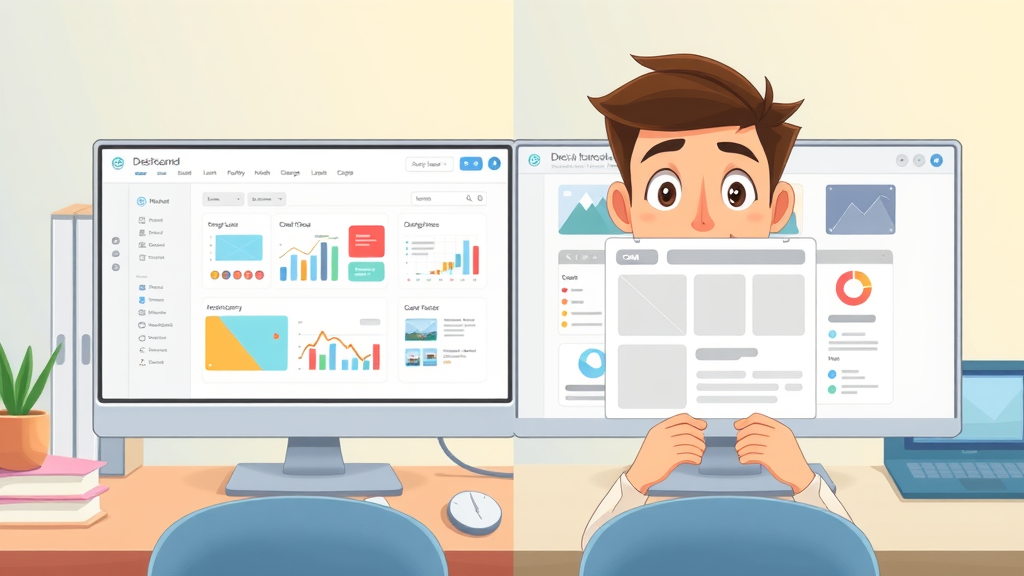Did you know that over 90% of websites today use a content management system (CMS) for their daily operations? If you’ve ever wished for an easier way to update web pages or manage digital content—even with zero technical skill—this guide is for you. Whether you’re an entrepreneur, blogger, or small business owner, the right CMS platform can revolutionize how you manage your site, provide powerful customer experiences, and keep you ahead of the competition.
Over 90% of Websites Rely on a Content Management System—Here’s Why That Matters
- Discover how a content management system can revolutionize your online presence, regardless of your technical background. Uncover surprising industry statistics and practical examples demonstrating their power.

The astonishing adoption rate of content management systems highlights their significance in today’s digital world. Most websites worldwide depend on a management system to easily create, update, and publish content. This isn’t just technical jargon—leading CMS platforms like WordPress, Joomla, Shopify, and Wix empower individuals and businesses to manage content, digital assets, and customer experiences with minimal fuss. For example, a bakery can post daily specials, a community blog can publish stories in minutes, and an ecommerce store can update product listings—all thanks to the streamlined workflows of modern CMS software.
Beyond sheer adoption, the shift to content management systems drives website consistency, supports multichannel content delivery (from web pages to mobile apps), and integrates key marketing tools. For web creators and business owners, embracing a CMS system is no longer optional—it’s a strategic move. The robust capabilities of a good content management system allow even non-coders to maintain an up-to-date, visually stunning web presence that boosts both engagement and visibility.
Understanding Content Management System Fundamentals
What is a Content Management System and Why Is It Essential?
- Explore the core concepts that define content management systems, and learn why they are integral for modern content creation and management.
A content management system (CMS) is a software application designed to let users easily create, edit, and publish web content —with no need for specialized technical skills. What sets a CMS platform apart from barebones HTML coding is its user-friendly dashboard, intuitive content creation tools, and ability to manage digital assets like images, videos, and downloadable files all in one place. By abstracting away the technical complexity, a management system empowers content creators to focus on what matters: publishing engaging stories, building attractive web pages, or marketing an online store.
CMS platforms are more than just a tool—they’re the backbone of millions of sites, from hobby blogs to enterprise portals. With built-in workflows for version control, SEO, social media integration, and even e-commerce functionality, a content management system becomes an enabler for business growth, team collaboration, and streamlined updates. This combination of flexibility and simplicity is why so many organizations rely on a content hub approach, using a central CMS to manage their entire digital footprint efficiently.
Today, whether you’re maintaining a company knowledge base or publishing a viral blog post, a CMS makes it possible to adapt quickly to changing demands—and deliver a consistent customer experience across all your channels.
Content Management vs. Website Builder: Key Differences Explained
- Clarify distinctions between a cms platform, website builder, and site builder through real-world scenarios and usage cases.

Although many use the terms interchangeably, there’s a significant difference between a content management system (CMS) and a website builder or site builder . A website builder like Wix or Squarespace offers an all-in-one, drag-and-drop experience for quickly creating web pages—ideal for those wanting to publish a simple portfolio or brochure site. Their focus is ease of use and fast setup.
In contrast, a CMS platform such as WordPress, Joomla, or Drupal provides far more customization, scalability, and content management power. A CMS lets you create robust multi-page sites, integrate advanced marketing tools, manage digital assets, and support multiple users with varied roles. For example, a news portal managing hundreds of articles daily or an online store with complex catalogs would be best served by a CMS. The distinction lies not just in features, but in long-term flexibility: while a website builder may suffice for a personal blog or small business landing page, a true CMS system is built for growth, integration, and omnichannel content delivery.
Ultimately, if you need to manage substantial content, require plugins or custom features, or expect your site to grow, choosing a management system will give you far more control and future-proofing than a typical website builder.
Management Systems in the Digital Age: A Historical Perspective
- Trace the evolution from early management systems to today’s comprehensive cms platforms and digital asset tools.
The history of content management systems traces back to the static days of hand-coded HTML web pages. As the internet exploded in scope, the need for centralized tools to manage content and digital assets became obvious. The first generation of CMS software offered basic publishing and editing. Over the years, these evolved into powerful cloud-based platforms capable of not only managing content but also digital marketing, ecommerce, and multichannel operations.
Modern management systems integrate with social media, enable content hubs for unified brand messaging, and expand into the realm of headless CMS —where content is created once and distributed everywhere, from web to mobile app. This evolution mirrors the changing landscape of digital marketing, customer expectations, and the demand for seamless, real-time updates.
As we move further into the era of omnichannel customer experiences, management systems are poised to remain the linchpin of successful digital strategies, empowering teams to adapt and innovate regardless of evolving technology trends.
How a Content Management System Streamlines Your Site Management
Simplified Content Creation, Editing, and Publishing
- Understand intuitive content creation workflows—no technical skills required.

A hallmark feature of any leading content management system is its ease of use. With intuitive dashboards and WYSIWYG editors, even users with minimal technical skill can author, tweak, and publish content across web pages or mobile apps. Features like drag-and-drop interfaces, media galleries, and revision histories mean that content creators can focus on storytelling without worrying about code or layout intricacies.
For businesses, a CMS software platform centralizes content workflows, allowing teams to collaborate on articles, manage drafts, schedule publications, and assign roles for editors and contributors. From blog posts to landing pages, every type of digital content can be handled with a few clicks. This not only accelerates the publishing process but also ensures consistency and quality across the entire site.
Moreover, integrated SEO tools, social media sharing options, and analytics dashboards empower publishers to optimize their content for maximum reach and engagement—making a CMS system not just a content management tool, but a gateway to broader digital marketing strategies.
Efficient Digital Asset and Content Delivery Management
- Unpack how management systems keep your images, documents, and media resources centralized and easily accessible.
Beyond text, today’s cms platforms excel in managing a wide array of digital assets—images, videos, PDFs, and marketing materials. By organizing everything in a single hub, a content management system ensures that assets are easy to locate, update, and reuse across different pages or web projects.
Centralized digital asset management eliminates redundancy and clutter, making it easier to maintain consistent branding, update product galleries, or share assets with remote collaborators. Many platforms even offer automatic image optimization, responsive delivery for mobile devices, and content delivery network (CDN) integration for faster global loading.
The result is a seamless workflow where assets flow easily from creation to publication, supporting rich multimedia experiences and optimized customer journeys on both desktop and mobile.
Centralized Control: The Content Hub Advantage
- Learn why businesses increasingly leverage content hubs within their content management system landscapes.
A modern content management system isn’t just about individual web pages—it’s about creating a unified content hub . This “single source of truth” approach lets organizations orchestrate blog posts, landing pages, media files, and even documents from one interface, streamlining both creation and governance.
The content hub advantage means your brand speaks in one voice, everywhere. Updates made in the hub are reflected across all your digital properties, eliminating outdated information and boosting consistency.
Centralized control also enhances collaboration, security, and analytics tracking, helping businesses stay nimble in fast-changing markets and deliver top-tier customer experiences.
Choosing the Right Content Management System: CMS Platform Deep Dive
Popular CMS Platforms Compared
| CMS Platform | Ease of Use | Scalability | Plugin/Extension Support | SEO Features | Pricing | Unique Features |
|---|---|---|---|---|---|---|
| WordPress | Very Easy | High | Extensive | Strong | Free/Core + Paid Themes/Plugins | Massive community, flexible site builder |
| Joomla | Moderate | High | Good | Good | Free/Core + Paid Extensions | Best for complex site structures |
| Drupal | Steep Learning Curve | Very High | Powerful | Very Strong | Free | Enterprise-level flexibility, security focus |
| Shopify | Very Easy | High | Extensive via App Store | Strong | Subscription | Purpose-built for online stores |
| Wix | Extremely Easy | Moderate | Decent | Good | Free/Core + Subscription | Visual drag-and-drop builder, ideal for beginners |

When comparing popular CMS options , businesses should look closely at usability, plugin availability, scalability, SEO functions, and cost. For example, WordPress is the reigning champion of flexibility and community support, ideal for content creation of all kinds. Joomla and Drupal offer advanced control for developers, while Shopify is purpose-built for online stores. Wix, on the other hand, stands out for its drag-and-drop simplicity, making site building accessible for everyone. Most CMS platforms now offer extensive integration options to connect with marketing tools, third-party services, and content delivery networks.
The right choice depends on your technical skills, content management needs, and growth ambitions. Regardless of your decision, a modern content management system delivers the framework to grow your digital presence with confidence.
Small Business Success Stories Using Content Management Systems
- Explore case studies where small businesses thrived using content management solutions.
Small businesses have leveraged content management systems to propel themselves from local operations to global brands. For instance, a boutique clothing store used Shopify’s CMS platform to turn their brick-and-mortar shop into a thriving online store—streamlining product updates, automating inventory, and integrating social media marketing. Meanwhile, a neighborhood cafe launched a WordPress-powered site to publish content about daily menus and events, dramatically increasing foot traffic.
These success stories highlight a key advantage: management systems allow small businesses with limited technical skill to maintain professional, fully functioning digital presences. With features like content scheduling, user permissions, and analytics, owners can focus on business growth rather than technical complexity.
As more small businesses move online, choosing the right CMS system is often the difference between stagnation and expansion—unlocking new revenue, improved customer experience, and future scalability.
Exploring Headless CMS: Modern Approaches to Flexibility
- Understand how headless cms platforms decouple content creation from presentation, facilitating omnichannel delivery.
The rise of headless CMS platforms marks a revolution in content management system design. Unlike traditional CMS platforms—which tie content creation and web design tightly together—a headless CMS separates the two. Content is created and stored independently, then pushed to any front-end channel, whether it’s a website, mobile app, or smart device.
This decoupling enables truly omnichannel content delivery, allowing brands to manage and reuse content across many digital touchpoints without duplicate work. Developers appreciate the freedom to use any technology stack for the user interface, while marketers maintain full editorial control from a central content hub.
For rapidly evolving brands or businesses expanding into multiple platforms, a headless content management system ensures future-proof flexibility and reach.
Essential Features of a Robust Content Management System
Technical Skill Independence: User-Friendly Design
- Feature breakdown of intuitive dashboard navigation, drag-and-drop site builders, and support for non-coders.

Modern content management systems prioritize user-friendly design so that even non-technical users can confidently manage content, design pages, and update digital assets. Most CMS platforms offer dashboard navigation that is visually intuitive, with clear menus, icons, and built-in help resources.
Drag-and-drop site builders have become industry standard, giving users the power to design and launch attractive web pages without ever touching code. This accessibility not only democratizes content creation but also empowers small teams and individual creators to build out feature-rich sites quickly. User guides, video tutorials, and live chat support are commonly available.
By removing technical barriers, the right content management system puts creativity and control back in the hands of the people who know their brand best—streamlining content creation and update cycles at every stage.
Scalability and Integration Capabilities
- See how cms platforms accommodate growth, plugin/extensions, and seamless integration with social media.

A robust cms platform is built for growth. Whether your business is doubling in size, adding new product categories, or expanding into new countries, scalability is vital. This is achieved through modular architecture, plugin/extensible support, and APIs that let you connect almost any third-party service or marketing tool.
Integration with social media, email marketing, and analytics tools is now a cornerstone of most content management systems. For example, you can automatically publish posts to Facebook or Twitter, pull in real-time analytics, or connect with e-commerce platforms to manage product catalogs.
Future expansion is also supported by cloud hosting, multi-site management features, and headless CMS options. As your needs evolve, your CMS platform should be able to add new functionality—ensuring you never outgrow your digital foundation.
Security and Reliability in Management Systems
- Best security practices for safeguarding digital assets and user data within content management systems.
In an era of increasing cyber threats, strong security and reliability are non-negotiable for any content management system. Leading CMS platforms employ best practices such as two-factor authentication, encrypted connections, automated backups, and granular user roles to safeguard websites from attacks.
Regular updates, active developer communities, and vetted plugin ecosystems add further layers of protection. Many CMS software offerings now provide built-in security monitoring, vulnerability patches, and support for compliance standards like GDPR.
Reliable uptime, disaster recovery options, and strong technical support ensure your web pages and digital assets are always available—reducing risk while maintaining a strong, trustworthy online presence.
Implementation Guide: Setting Up Your Content Management System
Step-By-Step Onboarding with Your CMS Platform
- Detailed checklist: Installation, configuration, and launch of your chosen content management platform.
- Choose your CMS platform (e.g., WordPress, Joomla, Drupal, Shopify, Wix).
- Select a hosting provider suitable for your chosen CMS.
- Install the CMS software via one-click installer or manual download.
- Configure core settings (site name, timezone, branding, and default language).
- Install essential plugins or extensions for SEO, security, and analytics.
- Pick a template/theme and lay out your primary web pages.
- Add initial content and set up navigation menus.
- Test your site for responsiveness, security, and user experience.
- Launch your site, then continuously manage content and updates via the CMS dashboard.
Customizing Themes and Templates
- Adapting site design to perfectly suit your brand with templates and third-party options.

The visual identity of your website is just as important as the content. Customizing themes and templates allows you to seamlessly blend brand colors, fonts, and layouts within your CMS platform. Most CMS systems offer a marketplace of both free and premium templates, along with support for third-party designs.
With drag-and-drop customization and CSS support, you can fine-tune every element, from homepage banners to content hub layouts. Advanced users may leverage developer tools for deeper customizations, while plugin libraries extend functionality for e-commerce, social media, and lead capture.
This combination of prebuilt options and customization ensures your content management system can evolve with your brand—keeping your site modern, engaging, and perfectly aligned with your goals.
Managing Content Creation and Delivery Across Devices
- Optimize content delivery for desktops, tablets, mobile—ensuring a seamless user experience everywhere.
In today’s multi-device world, a successful content management system must support responsive design and robust content delivery . Leading CMS platforms enable you to preview how pages render on any device—desktop, tablet, or smartphone—and make adjustments as needed.
Mobile-friendly themes, adaptive image delivery, and content optimization tools ensure that customers enjoy a smooth, visually consistent experience no matter how they access your site. These capabilities also drive SEO, as search engines now prioritize mobile-optimized web pages in their rankings.
For organizations with broader content distribution needs, headless CMS integration allows for delivery to mobile apps, voice assistants, and other innovative touchpoints—maximizing your reach through one centralized management system.
Leveraging Content Management Systems to Grow Your Business
Boosting Engagement Through Advanced Content Management
- Leverage integrated social media tools, SEO, analytics, and content scheduling via your cms platform.
Advanced content management systems offer rich capabilities for boosting user engagement and driving traffic. Built-in social media integrations allow you to publish content directly to popular platforms, schedule posts ahead of time, and analyze engagement without leaving your CMS dashboard.
SEO optimization tools guide content creators in structuring headlines, metadata, and links for best search rankings, while analytics plugins provide real-time insights into customer behavior. This complete suite of tools minimizes the need for separate marketing platforms, making your CMS system a one-stop shop for online growth.
For businesses, the combination of automated content distribution, tracking, and optimization lays the foundation for continuous improvement and audience expansion.
Transforming Your Site for E-Commerce and Online Services
- Unlock features for product management, online sales, and service booking.

E-commerce thrives on the ability to adapt quickly—launching products, managing sales channels, and serving customers online. Many content management systems now include native support for online stores, letting you add product pages, manage orders, integrate secure payment processing, and offer promotions right from the CMS interface.
Shopify, WooCommerce (for WordPress), and similar platforms blend advanced store management tools with an accessible content hub approach. This synergy allows business owners to publish content, run marketing campaigns, and analyze sales in real time, all from a single platform.
Service providers can benefit as well, with features for appointment booking, secure client portals, and membership management—enabling a diverse range of online businesses to flourish using modern CMS solutions.
Scaling for Future Expansion with Management Systems
- Future-proof your website with management systems that easily handle increasing users, data, and content types.
Growth is at the heart of every successful business strategy, and the right content management system ensures your site can grow with you. Modern CMS platforms offer scalable databases, multi-user environments, and cutting-edge APIs for integrating new tools or services as your needs evolve.
Whether it’s adding new languages, launching web pages for regional offices, or supporting high user volumes during peak seasons, robust management systems provide the stability and flexibility required for sustainable expansion.
This scalability, combined with automated workflows and centralized administration, means you’ll be ready for tomorrow’s challenges—no matter how your market or technology shifts.
Overcoming Common Challenges with Content Management System Adoption
Technical Skill Gaps: Training and Support Resources
- Identify support avenues and training materials for users at all technical levels.
While content management systems are designed for ease of use, the learning curve can still intimidate some users. Most major CMS platforms address this by offering comprehensive training resources: support forums, documentation, tutorials, and video guides tailored to all skill levels.
Companies can also invest in tailored onboarding programs or on-demand webinars, while dedicated communities allow users to troubleshoot issues collectively. Third-party support services and consultants are readily available for complex projects or specialized integrations.
By proactively leveraging these training avenues, individuals and teams can quickly overcome technical skill barriers and unlock the full power of their chosen management system.
Migrations and Upgrades: Best Practices
- Safely transition from legacy systems or other cms platforms without data loss.

Migrating content to a new cms platform or upgrading an existing one requires careful planning. Start by auditing your current digital content, backing up all assets, and researching migration tools or plugins provided by your new CMS. Many platforms offer import/export features or step-by-step guides to minimize disruption.
Beta environments are crucial for testing site functionality before the public switch. Pay attention to SEO implications—ensure URLs, metadata, and redirects are properly set up to preserve search rankings.
With the right preparation, you can move to a more powerful content management system, enhance features, and secure your data—all without risking performance or discoverability.
Avoiding Content Silos with Integrated Content Hubs
- Maximize efficiency and collaboration by centralizing content and assets.
Content silos—where information is isolated across teams or platforms—can cripple productivity. By embracing an integrated content hub via your content management system, you centralize storage, streamline approval workflows, and provide a holistic view of all assets.
This centralization makes it easy to repurpose content across campaigns, maintain draft consistency, and ensure everyone’s working with the same up-to-date materials. Built-in collaboration tools and permissions reinforce security and compliance without sacrificing agility.
An efficient, accessible content hub not only accelerates content creation but also eliminates costly redundancies and miscommunications—driving better customer experiences and stronger organizational alignment.
What You Need to Know Before Selecting a Content Management System
Key Considerations for Website Owners and Businesses
- Create a checklist of your budget, preferred support channels, customization needs, SEO requirements, scalability goals, and required integrations.
- What is your budget for setup and ongoing maintenance?
- What type and level of support do you require (community, live chat, managed)?
- How much customization does your brand or business model need?
- What are your core SEO and digital marketing requirements?
- Will your site need to scale significantly over time?
- What integrations (e-commerce, social media, analytics, etc.) are essential?
Determining the Right CMS Platform for Your Needs
- Decision framework to match your technical skill level, business objectives, and future ambitions.
Selecting the right cms platform hinges on a clear understanding of your team’s skills, current pain points, and future ambitions. If you prioritize simplicity and speed, a visual site builder like Wix or Squarespace may suffice. For long-term scalability, content hub features, and deep customization, a mainstream CMS system such as WordPress or Drupal is usually superior.
Balance your current needs with planned growth, integration expectations, and available support. Don’t hesitate to trial multiple platforms—most offer demos or free tiers—to see which feels most intuitive for your workflow.
Ultimately, the best management system empowers you to rapidly create, manage, and deliver digital content—no matter how your needs evolve.
What is the Content Management System?
- A content management system (CMS) is a software application or set of related programs that enable users to create, manage, and modify website content without specialized technical knowledge. It streamlines the process of publishing, editing, organizing, and deleting digital content from a central interface.

What is an CMS Example?
- A common example of a content management system is WordPress. Other leading examples include Joomla, Drupal, and Shopify. These systems provide intuitive interfaces and feature sets for managing web content.
What is the Most Commonly Used CMS?
- WordPress is the most widely used content management system, powering over 40% of all websites globally. Its ease of use, flexibility, and massive plugin ecosystem have made it the industry leader.
What is the Best CMS for Beginners?
- For beginners, WordPress, Wix, and Squarespace are strongly recommended. These platforms offer user-friendly dashboards, comprehensive documentation, and community support that simplify web management for new users.
Top FAQs Regarding Content Management Systems
-
How secure are content management systems?
Most CMS platforms follow industry best practices for security, including regular updates, encrypted connections, and user permissions. However, security also depends on strong passwords, timely updates, and careful plugin selection. -
Can you migrate between CMS platforms?
Yes, most CMS systems offer tools and documentation for migrating content, but careful planning is required to avoid data and SEO losses. -
Do you need coding skills to use a CMS?
No, the majority of modern CMS platforms are designed for non-technical users, offering visual editors and drag-and-drop tools. -
How do management systems help with SEO?
Built-in SEO modules streamline metadata, links, sitemaps, and page speed optimizations to improve site visibility on search engines.
Expert Insights on Content Management Systems
"A powerful content management system enables organizations to deliver consistent brand experiences and respond quickly to changing market demands." — Web Technology Analyst
Comparison Table: CMS Platform Features at a Glance
| CMS Platform | Ease of Use | Scalability | Plugin Support | SEO Tools | Pricing Model |
|---|---|---|---|---|---|
| WordPress | Very Easy | Excellent | 10,000+ plugins | Strong | Free/Open Source + Paid |
| Joomla | Moderate | Excellent | 7,000+ extensions | Good | Free/Open Source |
| Drupal | Advanced | Enterprise-grade | 8,000+ modules | Very Strong | Free/Open Source |
| Shopify | Very Easy | Excellent for eCommerce | 5,000+ apps | Strong | Subscription |
| Wix | Extremely Easy | Good | Decent selection | Good | Subscription |
Quick Reference: Essential Content Management System Terminology
- CMS: Content Management System
- Headless CMS: CMS where back-end content management is separated from front-end delivery
- Digital Asset Management (DAM): Centralized storage for images, videos, and files
- Content Hub: Central repository for all digital content
- Plugin: Add-on that extends CMS functionality
- Template: Pre-designed site layout or style sheet
Key Takeaways for Mastering Content Management Systems
- Over 90% of websites rely on a CMS for efficient, scalable content and asset management.
- Choose a platform that matches your technical skills, business requirements, and growth ambitions.
- Use content hubs and integrated digital asset tools to maximize efficiency and collaboration.
- Prioritize security, scalability, and ongoing support for long-term site success.
Elevate Your Content Management: Contact Our Experts
- Ready to transform how you manage your website? Call us at (385) 469-1869 or email at info@solu4u.com today!
Streamlining Your Website With Content Management Systems (Video Overview)
- Watch a concise explainer video—see how a content management system simplifies web operations from start to finish.
Tutorial: Setting Up a Content Management System from Scratch (Video Demonstration)
- Visual step-by-step demo for setting up, customizing, and managing a site with a leading content management system.
- Explore real-world examples on video—how SMEs leverage their CMS platform to drive results.
Conclusion
Choose a content management system that matches your needs, leverage training and support, and future-proof your business by adopting robust, secure, and scalable digital platforms.
Sources
- https://wordpress.org/about/
- https://www.joomla.org/about-joomla.html
- https://www.drupal.org/about
- https://www.shopify.com/enterprise/cms
- https://support.wix.com/en/article/what-is-wix
- https://www.wpbeginner.com/
- https://www.contentful.com/r/knowledgebase/headless-cms/
To deepen your understanding of content management systems (CMS), consider exploring the following resources:
-
“What Is a Content Management System (CMS)? The 2024 Guide” : This comprehensive guide by Semrush offers an in-depth look at various CMS platforms, their features, and how to choose the right one for your needs. ( semrush.com )
-
“What is a content management system (CMS) and how does it work?” : Adobe’s article provides a detailed explanation of CMS functionalities, including insights into popular enterprise CMS platforms and their capabilities. ( business.adobe.com )
These resources will provide you with valuable insights into selecting and utilizing a CMS to enhance your website management and digital content strategy.
 Add Row
Add Row  Add
Add 




Write A Comment